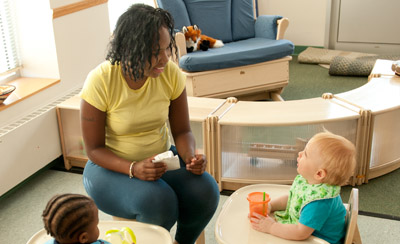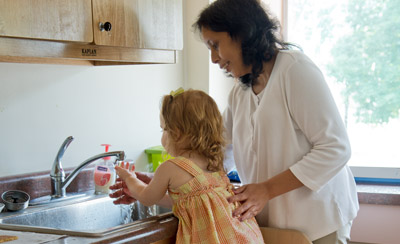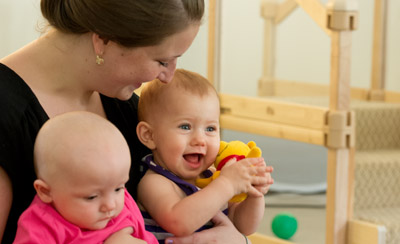What is the Pedagogy of Care?
| August 2016“We sometimes speak as if caring did not require knowledge, as if caring for someone, for example, were simply a matter of good intentions or warm regard. But in order to care I must understand the other’s needs and I must be able to respond properly to them, and clearly good intentions do not guarantee this. To care for someone, I must know many things.”—Milton Mayeroff
As an early childhood teacher are you surprised by the amount of time you spend in caring tasks? Do you ever feel that the dishes you have to wash, the diapers you change, or the noses to wipe are getting in the way of teaching? What if we adopted a new way of thinking about care and incorporated it into our pedagogy. We know that for a young child each moment is a learning opportunity. So each moment of caring for a child holds all the essential components of teaching such as observing, listening, scaffolding, and reciprocity. What would our practice look like if we lifted up the mundane tasks of caring to be valued as educational? How could we define the pedagogy of care?
The pedagogy of care is a science.Now more than ever, we possess the brain research that demonstrates what we’ve always known instinctively: children are learning from the moment they are born and the most meaningful lessons are embedded in care. Nothing drives learning as powerfully as eye contact, touch, and voice—the essential elements in the pedagogy of care.
The pedagogy of care is an art.Early childhood teachers practice slowing down and creating respectful intelligent care partnerships throughout the day. In daily rituals such as hand washing, serving meals, diapering babies, and zipping coats we transform mundane tasks into educational practices.
The pedagogy of care breaks down the false dichotomythat there is a difference between early education and care. In the past, caring tasks may have been viewed as custodial, mere babysitting, something anyone can do. In the emerging future, care is viewed as an honorable teaching practice requiring specialized knowledge about learning and early development. How we touch others increases or diminishes their human dignity. In childhood, the sensations of the body are the path ways to the child’s thoughts, emotions, and attitudes. Caring routines involve engagement around bodily functions (elimination, cleaning, eating, sleeping) and therefore they hold the most intimate importance. Respectful caring is the key to growing trusting relationships and intellectually stimulating education. The way we care for children’s bodies reflects the way we care for their hearts and minds.
We ask ourselves, how does the way we practice care demonstrate that the wellness of children, teachers, and families is connected? How do we teach in a way that lifts up care for all and demonstrates the essential role of care in building an infrastructure for a strong society? For a starting point, we can engage in a self-study by looking closely at transitions, meals, sleeping, toileting, and dressing routines and reflect upon the following Principles of Authentic Care:
Authentic care is a PARTNERSHIP:When we see the other as competent and capable, we follow the advice of Ron Lally to engage in “relationship planning rather than lesson planning”. We practice caring as a conversation—a reciprocal exchange. Following one of Emmi Pikler’s principles, we find ourselves doing it “with” children instead of doing it “to” children. We do not impose our direction on children.
Our presence and availability is spoken through our body language. Are we eating with children during meals or hovering over their heads? Are we yelling out directions from across the room, or sitting on the floor and seeking eye contact? Are we in a place to give and receive a relationship? As we practice authentic care we also grow as teachers and humans.
Authentic care is nurturing another towards INDEPENDENCE:We view care as a teaching practice that encourages the growth of the child. Authentic caring nurtures development, actualization, and self-sufficiency. This is the opposite of caring in a way that creates helplessness, frustration, dependency, or entanglement. The recipient feels his or her wholeness in our caring response. To care well, we must cultivate knowledge of human development and early education as well as seeking to know the individual child. We ask, do children have opportunities to “do it by myself” throughout the day or are they handled and directed by others? Do children know the schedule and understand the use of materials so they can experience their agency and control while they move through transitions?
Authentic care is an EXPRESSIVE ART:Caring rituals include thoughtful organization that allows us to celebrate the teaching opportunities that exist in everyday moments. Teachers are skillful in using the invisible arts of care as teaching tools—such as voice, touch, listening, and being present. We think about TIME as a material and practice slowing down. We create beauty in the human exchange in tangible ways for example, in the manner meals and snacks are presented. We ask, do children have opportunity to eat with real utensils, to drink from child sized glass cups, to serve their own food, and to dress themselves with supportive assistance? Do we have the tools to engage in the expressive art of caring? Are rooms full of natural light? Are there sinks, lovely dishes, bathrooms, washing areas, and comfortable eating spaces?
Authentic care includes a CURRICULUM OF CARE for children:We see children as caring. We offer children the opportunities to care for materials, small animals, plants, and one another. We ask—do children have opportunities to be known to one another through care? Do they experience their citizenship through authentic caring exchanges?
In her book, Starting at Home: Caring and Social Policy, Nel Noddings offers an interesting analogy. She describes how educators are trying hard to increase participation in mathematics and science for girls. The rationale behind this is that women have been deprived of opportunities by their lack of preparation in these subjects. It worries our society that women lag behind young men in skills that are so highly valued. Noddings elaborates that it is unfortunate that society is not worried that young men lag behind women in caring skills, in preparation for future nursing and early childhood careers, and parenting because these traditionally female occupations are not highly valued. Dr. Noddings makes the point that men have “long been deprived of many of the joys that accompany everyday caring and have not been encouraged to develop the skills and attitudes that make life deeply satisfying.” She challenges us with the question, how will we make caring attractive in our society?
References:
Emily Pikler (8 guiding principles) http://thepiklercollection.weebly.com/pikler-principles.html
J. Ronald Lally, Ed.D. https://www.pitc.org/.../03_Curriculum_and_Lesson_Planning.pdf This document may be reproduced for educational purposes. Curriculum and Lesson Planning A Responsive Approach. © WestEd, The Program for Infant/Toddler Care.
Mayeroff, Milton. 1971. On Caring. HarperCollins Publishers: New York, NY
Nodding, Nel. 2002. Starting at Home: Caring and Social Policy. University of California Press: Berkeley & Los Angeles, CA









